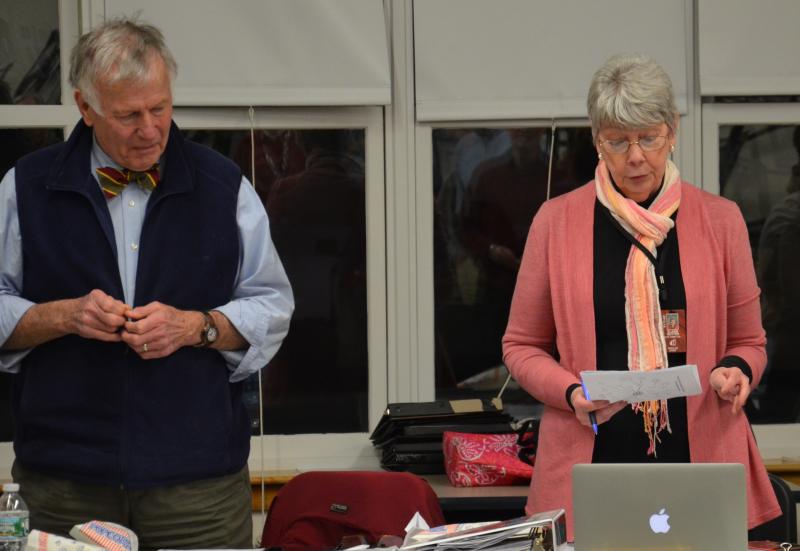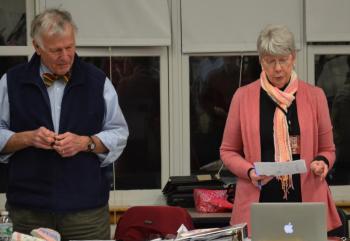Camden Hills High School board scrutinizes relationship with Midcoast School of Technology
ROCKPORT — The Five Town CSD School Board spent an hour Feb. 11 listing concerns and questions it has with the 30 year-old fiscal and academic relationship between it and the Region 8 Midcoast School of Technology in Rockland. By discussion’s end, the board unanimously agreed to assess the career and technical education needs of students attending Camden Hills Regional High School, and explore such programs are delivered elsewhere across Maine and elsewhere.
“The Midcoast School of Technology [MCST] has a good reputation,” said Five Town CSD board member John Lewis, of Camden, stressing that the conversation that night was not about the value of vocational education but about how the costs of supporting Region 8 school districts are apportioned.
“This is the time to clarify our relationship to get some kind of control and at least have a conversation,” he said.
Region 8 is part of a quasi-municipal corporate structure established by the Maine Legislature in 1973 to provide consistent career and technical education to high school students.
Each region is governed by a cooperative board. The Region 8 Midcoast School of Technology board consists of representatives of Islesboro, Monhegan, North Haven, Vinalhaven, RSUs 13, 40 and 65 (Matinicus), and the Five Town CSD.
Meanwhile, a Legislative committee was created last year and is reviewing the current funding formula of vocational centers and campuses across the state.
The goal of that committee is to “get it out of the hands of towns,” said committee member Donald Cannan, executive director of the nonprofit Maine Administrators of Career and Technical Education, whose mission is to promote and improve career and technical education throughout the state. He said the Five Town CSD school board is not the only district in the state having conversations about CTE funding.
The committee, consisting of four CTE directors, three superintendents and three CTE school business managers (MSCT’s business manager Sherry Moody sits on the committee), has met once. The task is to establish equitable funding and “get in line with a expenditure formula” and “get out of cost sharing,” he said.
Meanwhile, the community supporting Camden Hills Regional High School continues to address its own CTE model.
Lewis’ position was reinforced by two citizens attending the Feb. 11 regularly scheduled board meeting held in the Chorus Room at Camden Hills Regional High School on Route 90 in Rockport.
Alex Armentrout, of Rockport, represents the informal local group Value In Education, which operates as a watch dog of how taxpayer’s dollars are spent on education. He advocated for vocational education.
“There is an urgent need for young workers with the skills that such a program can provide,” said Armentrout. “Those skills will be ongoing.”
But, he added, the curriculum at MCST needs addressing, as well as the cost allocation by sending districts.
Camden resident David Lyman suggested that it is time to adjust the basic philosophy and mission of career and technical education. Call it instead, he said, with a new name, the “High School of Ideas.”
Incorporate art, science, design and technical innovation to, he said, “broaden our scope in training our people going forward in the creative economy.”
Camden Hills Regional High School is one of seven high schools that sends students to, or participates with, the Rockland Region 8 campus for career and technical classes. Additional high schools include Islesboro; Oceanside, in Rockland; North Haven; Vinalhaven; Medomak, in Waldoboro; and Lincoln Academy, in Wiscasset. Total enrollment as of October 2013 was 487 students. According to MCST numbers, the Five Town CSD was sending 115 students to the Rockland campus at that point in the autumn.
Other high schools sent the following number of students (or had participating programs on islands):
Oceanside (RSU13): 168
Medomak Valley High School (RSU 40): 126
Vinalhaven: 18
North Haven: 19
Islesboro: 19
This year’s budget at MCST is $2.85 million. Of that, the Five Town CSD pays $973,345, or 34 percent of the budget.
The other districts pay as follows:
RSU 13: $970,235
SAD 7: $15,549
SAD 8: $79,297
RSU 40: $754,109
Islesboro: $57,525
Career and technical education (CTE) is a statewide effort established in 1973 by the Maine Legislature.
There are 27 CTE schools in Maine with the purpose of providing technical skills that prepares students “for post-secondary education and entry into an ever-changing workplace and society and meet the rigorous academic standards of Maine's Learning Results,” according to the Maine Administrators of Career and Technical Education, the nonprofit that ties together the schools in Maine.
There are currently 7,979 Maine students taking CTE classes in regions and centers. Region 8 MSCT, in Rockland, is the local CTE hub. Taxpayers fund their respective portions of supporting MSCT through their annual education spending approved at June town meeting, and is qualified as tuition reimbursement from sending schools. Other CTE funding derives from state education funding and federal grants.
As of February, Camden Hills was sending 72 students to the Rockland MCST campus to take classes that include auto tech, auto collision, CNA medical science, design and marine technology, carpentry, small engine, welding, machine shop, hospital culinary, engineering, firefighting and emergency medical technician.
The funding issue
Five Town CSD Superintendent Elaine Nutter said at Feb. 11 meeting that ever since she assumed her position three years ago the school board has raised questions about the relationship with MCST, how costs are shared, and the specific proportion of costs born by the five towns.
“Here we are almost three years later, and we still have the same questions,” she said.
Nutter suggested it is time for a public discussion and to see “seek ways to move forward so we won't be here in another three years with same questions and concerns, and feeling stuck.”
She said that last spring, 90 Camden Hills students had enrolled in classes at MCST; since then, however, the number has decreased to 72.
Nutter sits on the MCST’s superintendent advisory committee. The committee’s last meeting was in December with but one other superintendent besides her in attendance.
Five Town CSD board member Tori Manzi, of Camden, said she sits on the MCST board of directors, as well as its visioning committee. The committee has been looking at other facilities and programs. Most recently, the committee opened bids for a facility and needs analysis, which is to begin in May.
“It's frustrating to get the dialog out into a bigger group,” said Manzi. “The [MCST] board does not operate like our board. I am so used to the ease of communications. We can argue with our superintendent or chairman and not feel like we are going to reprimanded later. There is freedom of speech on our board.”
Manzi said: “We have to open lines of communication. I don't know how to do that.”
Beth Fisher, director of MCST, was unable to attend the meeting but said in a telephone conversation and an email exchange that: “Allegations were made about the quality of our programming. As far as I know no statements were based on fact, only rumor and supposition. Just like traditional academic schools have NEASC reviews, we go through a rigorous review process as well for the entire school. We are scheduled for one next year.”
CTE programs must comply with national industry standards and each program offered must be preapproved by the Maine Department of Education or Maine’s education commissioner, after considering whether the program is necessary to the local area and economy. Fisher said MSCT has a high number of programs available to students compared to other areas of the state and, she said: “....more than half of our programs allow high achieving students to get college credit for the work they do here. We have ‘Dual Enrollment’ for machine tool, medical science, pre-engineering, graphic arts, culinary, EMT, and more. Next fall our horticulture program will also have that option. To get these agreements with the colleges we have to vet the teachers and curriculum.”
Fisher said the existing funding formula was ratified by all the sending schools in 2011, including the Five Town CSD.
“The funding formula has served the Region [8] well since the 1970s,” she said. “It has been reviewed on multiple occasions and each time the [CSD] board has renewed the formula believing this one to be in the best interest of the students we serve.”
Fisher said that over the past six years, Region 8 “has kept its budget virtually flat, although this year it looks like we will have a 2.9 percent increase.”
She attributed that budget increase mostly to wage and insurance increases.
“Our wage scales are lower than the CSD's for every position we have reviewed,” said Fisher. “Our teachers get paid less, our administration gets paid less, our business manager gets paid less, and so on, but we have to honor our labor contract as any district does and we have no control over the increase in health insurance costs. We have been holding our budget as lean as possible.”
Fisher said: “The reasons the CSD cost for CTE has increased this year is because their enrollments have increased in relationship to the other two large sending school districts (RSU 13 and RSU 40). We have no control over those demographics.”
She said Region 8 has responded to local school board requests to tighten the belt, but then has later seen significant increases in some of the sending school budgets.
“We have requirements such as increases in health insurance and wages that must be built into our budget in addition to repairs on an old building and the significant costs of equipment and supplies to run our programs,” she said.
The better graduation rate we have, the more the costs go up,” he said.
The sentiment at the Feb. 11 CSD board meeting was that Camden Hills Regional High School representatives needed to establish a stronger voice in the CTE discussion, and board members agreed that there was a flaw in the representational governance model now being used.
“How does that community voice get into that meeting,” asked one Five Town CSD board member.
Lewis noted that the Region 8 board is not elected; therefore, its members have no direct responsibility to the voters.
“To get them to understand our displeasure is difficult,” said Lewis.
Following Five Town CSD Board Chairman Gretchen Richards directed the meeting forward.
“Demand a change in allocation,” said Lewis. “If they refuse to talk to us, it demonstrates the size of the problem.”
He added: “The other districts are profiting from the way things are.”
“Wht is the best interest for the kids,” asked Camden Hills Regional High School Principal Nick Ithomitis.
He suggested building a center on the “14 acres this board just bought. This is a magnet school. People are looking to get here all the time. That's not a bad thing.”
“How much capacity do we have in this building to take on some career and technical classes,” asked Five Town CSD board member Eliza Haselton, of Rockport.
“We don't have the capacity to do it full blown,” said Ithomitis. “Give us $1 million and we could build something that could blow people away.”
The board members then began brainstorming ideas of changing CTE in the area, including creating options through CTE centers at area high schools, instead of sending students to one campus.
Could satellite programs be established at the high schools that students could choose and attend.
“Each high school would have a signature,” said one board member.
“That's like Many Flags,” another said. “Instead of having a campus in one place, there would be multiple campuses and kids sharing resources.”
The board then agreed to form a committee to explore needs and explore other ways that CTE is delivered in other areas of the country.
For Fisher, the goal remains to provide programs to students in the existing structure.
Event Date
Address
United States




























